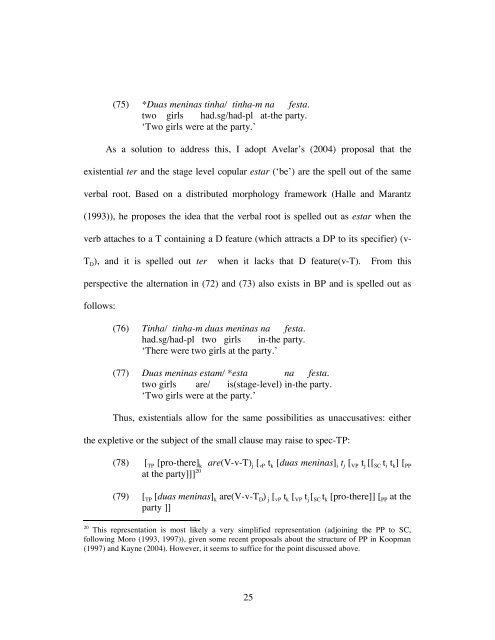Post Verbal Subjects and Agreement in Brazilian Portuguese
Post Verbal Subjects and Agreement in Brazilian Portuguese
Post Verbal Subjects and Agreement in Brazilian Portuguese
You also want an ePaper? Increase the reach of your titles
YUMPU automatically turns print PDFs into web optimized ePapers that Google loves.
(75) *Duas men<strong>in</strong>as t<strong>in</strong>ha/ t<strong>in</strong>ha-m na festa.<br />
two girls had.sg/had-pl at-the party.<br />
‘Two girls were at the party.’<br />
As a solution to address this, I adopt Avelar’s (2004) proposal that the<br />
existential ter <strong>and</strong> the stage level copular estar (‘be’) are the spell out of the same<br />
verbal root. Based on a distributed morphology framework (Halle <strong>and</strong> Marantz<br />
(1993)), he proposes the idea that the verbal root is spelled out as estar when the<br />
verb attaches to a T conta<strong>in</strong><strong>in</strong>g a D feature (which attracts a DP to its specifier) (v-<br />
T D), <strong>and</strong> it is spelled out ter when it lacks that D feature(v-T). From this<br />
perspective the alternation <strong>in</strong> (72) <strong>and</strong> (73) also exists <strong>in</strong> BP <strong>and</strong> is spelled out as<br />
follows:<br />
(76) T<strong>in</strong>ha/ t<strong>in</strong>ha-m duas men<strong>in</strong>as na festa.<br />
had.sg/had-pl two girls <strong>in</strong>-the party.<br />
‘There were two girls at the party.’<br />
(77) Duas men<strong>in</strong>as estam/ *esta na festa.<br />
two girls are/ is(stage-level) <strong>in</strong>-the party.<br />
‘Two girls were at the party.’<br />
Thus, existentials allow for the same possibilities as unaccusatives: either<br />
the expletive or the subject of the small clause may raise to spec-TP:<br />
(78) [ TP [pro-there] k are(V-v-T) j [ vP t k [duas men<strong>in</strong>as] i t j [ VP t j [[ SC t i t k] [ PP<br />
at the party]]] 20<br />
(79) [ TP [duas men<strong>in</strong>as] k are(V-v-T D) j [ vP t k [ VP t j [ SC t k [pro-there]] [ PP at the<br />
party ]]<br />
20 This representation is most likely a very simplified representation (adjo<strong>in</strong><strong>in</strong>g the PP to SC,<br />
follow<strong>in</strong>g Moro (1993, 1997)), given some recent proposals about the structure of PP <strong>in</strong> Koopman<br />
(1997) <strong>and</strong> Kayne (2004). However, it seems to suffice for the po<strong>in</strong>t discussed above.<br />
25

















